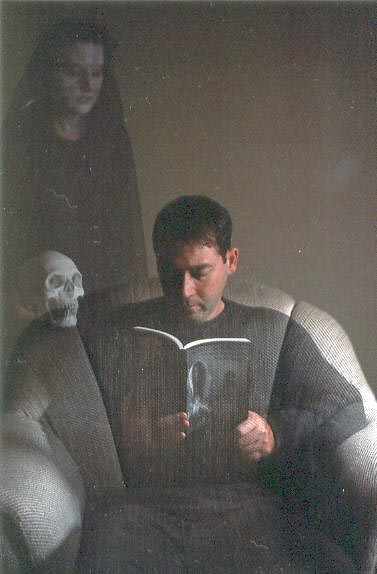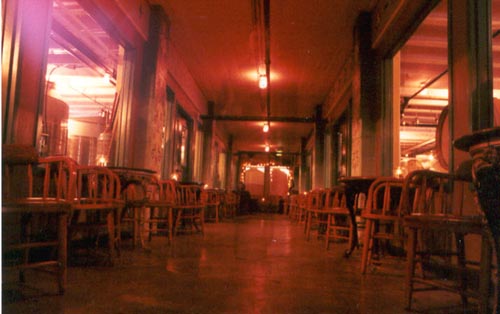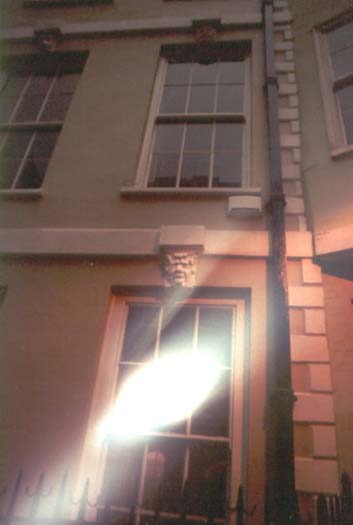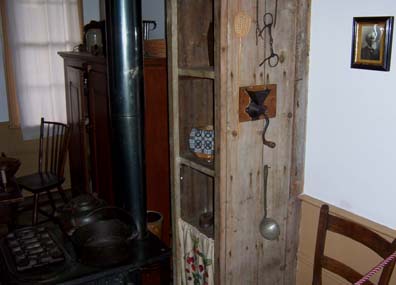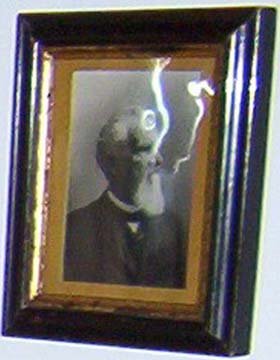___________________
|
Electromagnetic Radiation | Electronic Voice Phenomena | Infrasounds | Ghost Photography
Many of the people I have spoken to would be happy to find a natural explanation for their hauntings. Some of them live in real fear. If people who are disturbed by a haunting lay their ghosts through natural explanations, I believe that I am doing them a service. Even if they exhaust the natural possibilities, many people feel relieved to have done something. I am guessing that most novice ghost hunters have a keen interest in ghost hunting because their house is haunted. If you are serious about investigating your haunting and taking it to the press and scientific community, be thorough. You have to sort through multiple explanations for your haunting; including human fakery or mistaken human perceptions of mundane events. The first thing I recommend is that you keep a diary of everything that happens. If there are other people involved, have them keep a diary as well. Keep them separately without consulting with the other people. Don't discuss any incident until after you all write it down. Your second concern should be to look at the location. Try and find out the background of the site. Investigators have found that many hauntings are the result of seismic activity and underground water. This causes noises and shakings that people notice and then interpret as ghosts. Traffic can cause vibrations. It does not have to be heavy vehicle. Smaller vehicles can set up harmonic tremors that will cause objects to vibrate when other things seem to be still. Even in an urban setting, you would be surprised how many rivers and streams have been routed underground. In drier areas like the Inland Empire, if your ghost shows up during stormy weather, you may have an intermittent stream running under your house. There are several scientific instruments that you can buy to help you investigations. The best way to document the possibility of life after death is to have proof that can be shown to people after the incident. Given our technology, people have tried to get that proof on audio and visual media. There are some fields of research among some investigators. Among these fields (or fads?), are standard, Kirlian and infrared photography, Electronic Voice Phenomena or EVP, and Electromagnetic Radiation or EMR detection.
Electromagnetic Radiation or EMR is the latest phenomena that ghost hunters have tried to measure. In the 1930s George de la Warr, an English researcher found that the human body is surrounded by an electromagnetic field. This field is measurable and fluctuates, depending upon the physical and emotional state of the person. Some ghost researchers have detected changes in the local electromagnetic fields during paranormal events. I have seen some advertisements for EMR detectors from various firms, billing them as ghost detectors. You can also buy them through electronic supply houses like Radio Shack. Beware, we live in an electronic society and wiring shorts or appliances may fool your detector. All of the gizmos I have described are extremely valuable but they are only tools. Their efficiency is limited to reporting data to you. You have to trust your own senses, and know their weaknesses. Especially your eyes. Nighttime hauntings should be well documented, because your eye does not operate as well at night as it does during the day. Light enters the human eye through pupil where it then spreads out and passes through the retina where it activates the rods and cones. The cones allow us to see in bright light. They help us to see things in finer detail. The rods activate and operate levels of light, say inside buildings or at night. In the dark, when we use our eye's rods to see images are fuzzy and gray images rather than sharp and colored detail. At night, we all have a harder time seeing things directly in front of us and we see things better out of the corner of our eyes. This also means that we can see movement beside us. When we turn to face it the object may seem to disappear quickly or the detail changes from sharp to blurry and we don't see the same thing. The question of whether ghosts manifest themselves through psychic or with their own energy is an open question. What about the appearance and power of ghosts today? Does our belief (or disbelief) in ghosts give us the ability to see them? And does belief give them the power to hurt or help us? Despite all of the evidence and plausible explanations against ghosts and paranormal phenomena it is impossible to prove that they do not exist. To try and prove that they do exist, in some form or another is almost as difficult. Until recently, cosmopolitan 20th century society viewed ghosts as at best a curiosity, capable of rapping on tables and appearing in shadowy forms. At worst ghosts did not exist. With the advent of graphically horrifying slasher and demon possession movies there is a growing expectation that ghosts do have the power to again affect people through psychokinetic means. Some ghost hunters subscribe the theory that most ghosts are demons masquerading as the spirits of the dead. Their purpose is to lead us to evil and do harm. Not just houses, but people are open to possession by demons. The ritual of exorcism has been used frequently in the last few decades.
Electronic Voice Phenomena or EVP is the phrase used to describe the various ghostly-audio phenomena recorded over time. Strange noises and voices have been captured almost as soon as wire and tape recording was invented. People recording themselves in a haunted location have done this. In the background of the tape, voices or sounds that were not detectable when the tape was made are heard. Sometimes, questions are asked and ghostly answers are heard on tape. Detractors point out that some of these "replies" are almost inaudible or unintelligible. They believe that some of the interpretations of ghostly voices or words are instances where the researcher has listened to static so many times that they have convinced themselves the static is a voice. I have tried EVP recording in one location where I sealed a room and placed a tape recorder in the room. I was rewarded with some pretty dramatic sound effects (see the Vancouver Barracks Hospital). I would recommend a high quality tape recorder with a detachable microphone if you could afford one. That way you don't record the hum of your tape recorders motor. Cheap audio tapes produce lower quality sound, so use music/professional quality tapes.
In the mid-1990s Vic Tandy, an engineer from Coventry University was working late in his laboratory. As he worked he began feeling a strange sense of uneasiness and anxiety. It grew until he was sweating and shivering with fear. Suddenly he saw a gray figure appear out of the corner of his eye. When he turned to face it, the figure vanished. Tandy gathered his belongings and left hurriedly. He returned the next day and began work as usual. He had brought a fencing foil (one of his hobbies) with him. He put the sword in a vice to do some work on it. When he did this, he saw the tip of the sword vibrating wildly. He thought that low level sounds were responsible for the previous nights strange happenings. Tandy and others speculate that natural forces can generate high volume infrasonic sounds, which are below the range of normal hearing. These sounds can cause many strange effects to human perceptions. These include unexplainable fear, anxiety and even hallucinations. Tandy took some measuring devices to several locations in Britain that had a reputation for being haunted. In two locations he detected significant levels of subsonic vibrations. At one of the haunted buildings the infrasonic vibrations were caused by a wind tunnel operating the basement. Something similar could happen in an abandoned building with a broken or cracked window. In a high wind storm, the glass could vibrate and generate these sounds. If this window was located at the end of a long hallway the sounds would then be amplified as it echoed off the walls. This would take quite a bit of energy. And it does not explain all hauntings. Tandy did not detect infrasonic vibrations in all of the haunted locations he visited.
The following section is based in part on the photography section of my book Ghosts, Critters and Sacred Places of Washington and Oregon II One of the more spectacular aspects of hauntings are visual apparitions and photographs of ghosts. When people see ghosts, most of them see life like figures. Sometimes the figure is solid, other times it is transparent or fragmented, but it is almost always recognizable as human or human shaped. Most ghost photographs, particularly the ones taken many years ago show the same thing. Many of these older ghost photographs have been discredited as frauds. A small percentage of people who see ghosts do not see figures, they see luminous balls of light or something vaguely cloud like. There is a growing number of recent ghost photographs that do not show figures, they show glowing balls of light. More practically, a ghost photograph is a picture taken of a place or person where something that does not belong, (anomalous) shows up on the print and negative. This anomaly was not there when the photographer took the picture. When that happens, it is necessary for the photographer to eliminate all logical or natural explanations for this anomaly. When that is done, by process of elimination, most ghost hunters will proudly say, "I've got a ghost photograph!" This is not as easy as it sounds. In order to do this, you have to understand how photography works. You have to know something about the nature of light and how black and white, color and infrared film work. This will help any readers who have taken what they believe are ghost photographs troubleshoot their problems. It is like the difference between being able to drive a car, and being able to repair one if it breaks down. I know that this will be too technical for some casual readers. It will also be too vague for the physics students who read this. Sometimes there is no middle ground. At the end of this section I will list many common errors that can create false ghosts.
Light and Human Vision
All of these powers and zeros are confusing; so most people use the term nanometer or nm. With this conversion, the human eye sees light energy from around 400 to 700 nm. I have included all of these numbers to impress the physicists in the audience with my ability to quote useless facts. At one end of the visible spectrum we see the color violet, at 400nm (nanometers). At the other end of the visible spectrum we see red, at 700nm. When you look at a rainbow, what you are seeing is moisture in the atmosphere acting like a prism separating the light into its separate wavelengths. Our skin is a sensory organ and can detect infrared radiation that is invisible to our eyes. We know this as heat. This hits upon part of the argument surrounding ghost photographs. Many people believe that ghosts are a form of electromagnetic energy, and photographs can show ghosts because in some cases the photographic film is more sensitive to this energy than the human eye. Is this true? To understand a little of this, we have to understand how photographic film works. When light bounces off of an object, it passes through the lens of the camera and strikes the film inside the camera. Black and white film is made of several layers of material. The base layer is made of cellulose acetate (this is the thick, filmy stuff). A dark anti-halo layer if applied over the base. The anti-halo layer prevents any reflections from bouncing through the base layer and reflecting back into the light sensitive layer, which coats the surface of the film. This light sensitive coating contains microscopic crystals. When light strikes the film, the radiant energy in the light energizes the crystal and activates it. When the exposed film is placed in a chemical developer bath, the crystals turn into a black, metallic silver. This produces the negative image on the film, where light areas in the negative are dark on the photograph, and vice versa. Color photography uses multiple layers of chemicals that are sensitive to three kinds of light, red, blue and green. Each layer produces a negative image of the sensitive color and positive image of everything else in a complementary color. The blue layer produces a blue negative and positive in yellow. The green uses a positive in magenta and red uses cyan. People who use digital photo editors will find these color scales familiar. There is a belief that ghosts photographs are taken when a ghost passing in front of the camera too quickly to be detected by the human eye, but not too fast for a camera to capture. I will point out that if people use faster and faster films, then neither the human eye, nor the film would detect a ghost. The first ghost photographs were taken with photographic plates and early films, which had an ASA value of around 50. That means that the human eye should have been able to detect the ghosts. So what does that mean about the theory of quick ghosts? I can talk about spirits emitting energy in wavelengths above or below human vision though. To be brutally honest, people who believe that normal photographic film is more sensitive to a electromagnetic radiation than the human eye, are wrong. The sensitivity of any film to radiation is based on the chemical composition of the light sensitive layer placed on the film. With very few exceptions, normal commercial films (see the graph below) are designed to record images only within (or under) the range of human vision. There is of course the argument of infrared film.
This begins a bit outside the range of human ultraviolet perception and ends just below the upper red perceptions of our sight. The Ilford film is more sensitive to red and infrared light, ending just above of the human range of 700nm, at 740nm. The results of pictures taken with the Ilford film is just a little bit more sensitive than the human eye, unlike the Kodak film. As you can see from the same graph, the Kodak infrared film can detect light and energy both in the ultraviolet and infrared ranges, beyond human vision. It is sensitive to ultraviolet light beginning around 250nm and ranges up to the high infrared energy range at 900nm. I had an interesting email from a reader in Australia. He pointed out that the Kodak infrared film is very sensitive in the ultra-violet range. I did not highlight this too much. His had several good points about things I had missed describing about the dynamics of how this film works. (This is the mixed advantage of writing books with fans. Sigh) To me the most important thing was that he pointed out the fact that to use this film to take pictures in the ultra-violet range, you need a quartz glass camera lens and other kinds of filters. To me this raises the question about the nature of how ghosts turn up on film and pictures. Perhaps they do not show up as infrared signatures. We just assume that they are infrared because we experience cold in conjunction with paranormal events. Maybe they show up on infrared film because the film is also ultra-violet sensitive. These pictures are fuzzy or otherwise unclear because we don't have the right lens to take a picture of the ultra-violet ghost?
Taking Pictures Using Infrared Film In order to use both of these films to detect infrared radiation you must use a colored light filter. A Kodak Wratten, number 25 red filter will gather red light and concentrate it when you take a picture. At the same time, this filter will also allow visible light through, to be absorbed by the film and turned into a picture. So, a picture taken with the number 25 filter includes both visual and infrared light. A true infrared photograph, where only infrared light is recorded on the film must be taken using very dark red filter. The Kodak film is undoubtedly the best choice as far as it's sensitivity to infrared radiation. There are a great many drawbacks in handling and using it. You must keep it refrigerated prior to use and develop it quickly after you use it. It must be loaded and unloaded in absolute darkness. It must also be processed in absolute darkness. Many people do their own developing of this film rather than trust it to a photo lab. Although a home darkroom can become expensive and messy. The mechanics of focusing properly add to this problem with infrared films. Because the human eye cannot see into the infrared light range, we cannot focus a camera properly when using infrared film. This probably accounts for the blurry nature of some infrared pictures that I see on the Internet. Most older lenses do have an infrared focusing mark. On some lenses this will sometimes be marked with an "r". A camera book should tell you how to use it. Kodak recommends that infrared pictures be taken with the focus set on the smallest lens opening or aperture possible. This means that rather than having the lens set on f1.5 or f5, you should set it on the maximum of say f22. This is to aid in concentrating light on the film but it also aids in the focus problem. With a high f stop the lens will have the widest focus possible for objects in the background and foreground of whatever you have focused on. The drawback of this is that it means that any picture you take will again need a longer exposure time. You should be prepared to take exposures of longer than one second, even when using a flash. Many people today use the latest brand of point and shoot style cameras. If you are one of these people I suggest you check the camera instruction book to see if your camera has a program mode that can handle infrared film. Some use an infrared light beam shined on the film to read the film speed and count the number of exposures taken. This could cause blurring or over exposure of your film. If you have one of those nifty pocket zoom cameras that many amateur ghost hunters favor, you may not be able to purchase red or dark filters for your camera. No, fastening red cellophane paper to the lens of the camera with a rubber band will not replace a real IR sensitive filter.
Fake and non-Ghost photographs
If you are taking pictures through a window, be careful of reflections. Even if you do not use a flash, the window glass can act like a mirror. Just like it does in the photograph. to the left. Most modern "ghost" photographs are globes of light. One natural cause of this is called lens flare. If you take a photograph in natural light and point the camera toward the sun, a concentrated beam of light can enter the camera lens and overexpose a portion of the film. You may notice this as a white, hexagonal spot, if you took a fast exposure. This hex shape is due to the shape of the iris of the camera aperture devise. If you are taking a longer exposure, the iris shape will be blurred, because the camera is making some microscopic movements as you hold it. Lens flare spots can also be rainbow colored and rather oblong shaped. This can happen if you are taking a picture and the light is entering at an angle through the lens. The glass lens will act as a prism and create a rainbow colored spot.
You can achieve almost the same effect if you have a moderately new computer and a simple photo editing program. Many believers and non believers have created their own ghost photographs by taking several different photographs and layering them one on top of the other with different levels of opacity where they overlap. That is one of the reasons why I have a natural distrust of digital cameras and photography. It is not because they do not work, it is because you do not have a negative to show a skeptic.
So what about infrared film? I have used infrared film in a few places, such as the Vancouver Barracks. In this infrared photograph of the old hospital you can see that the ground looks like it is covered with snow. The inner portion of the tree branches are dark, while the outer portions are light. That is because the grass and the outer portions of the tree branches are warm... and light colored. The inner portion of the are cooler, and so darker.
The infrared photograph above is of the hallway in the wine tasting room at the Edgefield, in Troutdale. This room had been used as a final care room for older, terminal patients when the place was the County Poor Farm. Even at that time, the nurses felt the place was haunted. You may notice that there are several globes of light hovering above several of the tables and chairs. Are these the ghostly remains of departed spirits? The photograph below was taken with color film during the same visit. Please notice that on top of each of the tables is is a lighted candle. The infrared film was sensitive to the heat of the candle, to the point that the film actually blanked out the candle and holder because both were nearly as hot as the flame. One of the globes of light on the right hand side of the picture is actually a light/heat reflection in the window.
Why does the human eye see a figure, but the camera sees an anomalous shape? Another question might be, why do people see ghosts wearing clothes? Why don't we see naked ghosts, or balls of light or luminescent clouds? Maybe because our subconscious adds in details like clothing and features. This might explain how someone might subconsciously provide a paranormal explanation for natural phenomenon like flickering shadows, reflections or other natural disturbances to the environment. At the same time, this reasonable explanation conflicts with cases where an observer who knows nothing of a haunting "sees" a ghost and describes it in detail, down to gender, age, clothing, hair color and actions. When they describe the incident to others, it turns out that their description matches known details of a past resident of the house. It would be a strange coincidence for someone to have such a directed hallucination, unless there is some kind of a psychic projection from the ghost or spirit into the living mind. This might explain why the camera, which does not have conscious or subconscious sees only a ball of light instead of a human figure. But are the balls of light captured on camera true pictures of ghosts or are they explainable as tricks of light or even bad photography?
What about this picture? I took it outside of the 17th Century home of a man named Samuel Pepys, in London. Pepys has been seen several times on the ground floor and second story by people over the last decades. It was taken with standard color print film, (Fuji 800 ASA) just as the sun was setting. The sun was behind me, and the street lights were not turned on. You can see the shadows in the ledge, to the right. What could cause the globe and streaks of light?
This picture was taken by my friend Christina with her digital camera. There is something anomalous in the photograph hanging on the wall in the upper right hand corner of this picture
This is a close up of the original above. Unfortunately it was taken with a digital camera, so we cannot look at a negative to see more details. Is this a reflection from the camera flash? Overhead lights? Sunlight or is this a true "Ghost Picture?"
This brings me back to my first statement in the beginning of this book, "What is a ghost?" I still wonder and hope to find out. If you have any questions or comments or stories please write to me at PO Box 820203, Vancouver WA 98682 or email me at
Copyright © 2000 by Jeff Davis | Maintained by J. Goodman |

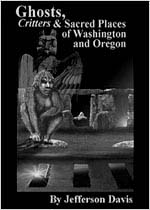



 We know that visible light is a
small part of the entire spectrum of electromagnetic energy (see the
illustration on the next page).
We know that visible light is a
small part of the entire spectrum of electromagnetic energy (see the
illustration on the next page).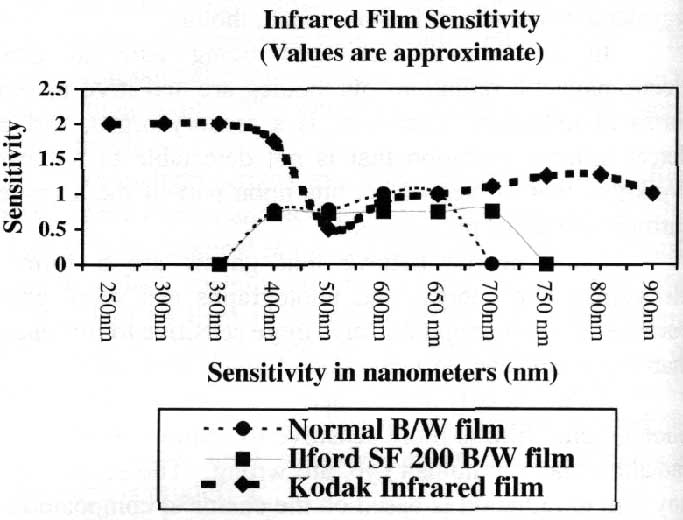
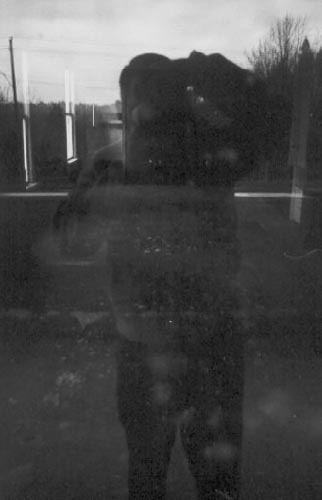
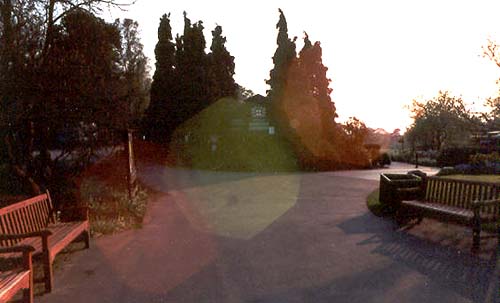 This
particular picture was taken by me in Hyde Park, in what used to be a suburb of
London. You can see that the sun is located just outside the frame in the
upper right corner of the photograph. Light is entering the lens at an
angle, causing three different hexagonal orbs crossing diagonally across the
picture.
This
particular picture was taken by me in Hyde Park, in what used to be a suburb of
London. You can see that the sun is located just outside the frame in the
upper right corner of the photograph. Light is entering the lens at an
angle, causing three different hexagonal orbs crossing diagonally across the
picture. 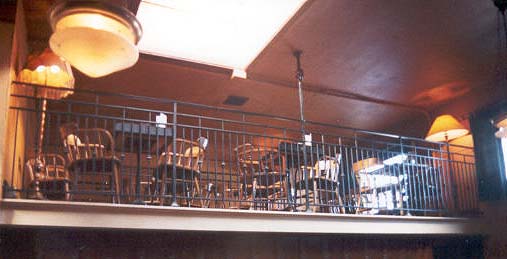 I
usually do not use a flash when I take pictures indoors. That way I can
avoid lens flare as well as light bouncing from a flash. At the same time,
I do get some strange light effects, because most of my pictures require an
exposure time of 1/16th of a second or longer. As in this photograph,
taken at the Olympic Club in Centralia. The upper bar is haunted by
the ghost of a man who was badly burned in a fire on the same site. If you
look in the upper right corner of this photograph you can see a Saturn shaped
globe and ring. This was caused by the light from the old fashioned light,
bouncing off the roof.
I
usually do not use a flash when I take pictures indoors. That way I can
avoid lens flare as well as light bouncing from a flash. At the same time,
I do get some strange light effects, because most of my pictures require an
exposure time of 1/16th of a second or longer. As in this photograph,
taken at the Olympic Club in Centralia. The upper bar is haunted by
the ghost of a man who was badly burned in a fire on the same site. If you
look in the upper right corner of this photograph you can see a Saturn shaped
globe and ring. This was caused by the light from the old fashioned light,
bouncing off the roof.